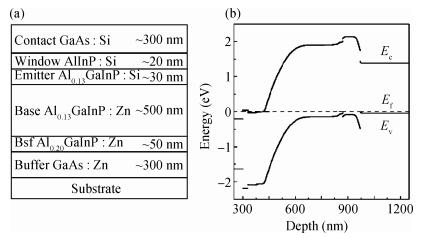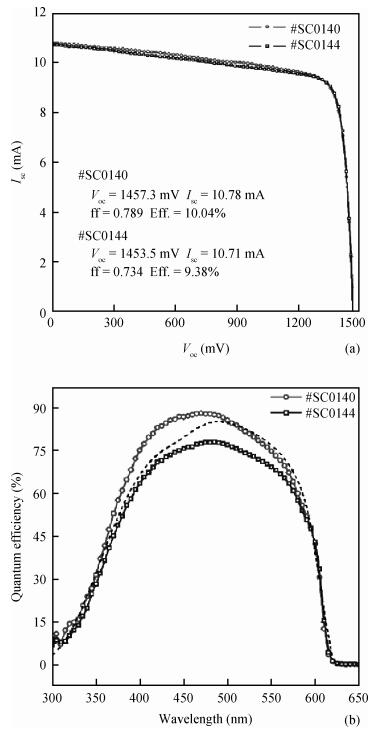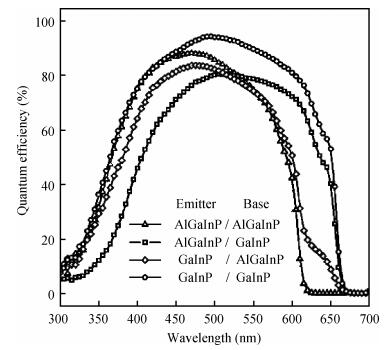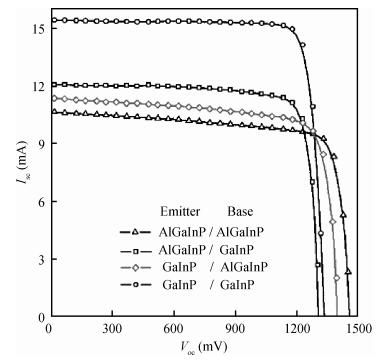| Citation: |
Hongbo Lu, Xinyi Li, Wei Zhang, Dayong Zhou, Mengqi Shi, Lijie Sun, Kaijian Chen. A 2.05 eV AlGaInP sub-cell used in next generation solar cells[J]. Journal of Semiconductors, 2014, 35(9): 094010. doi: 10.1088/1674-4926/35/9/094010
****
H B Lu, X Y Li, W Zhang, D Y Zhou, M Q Shi, L J Sun, K J Chen. A 2.05 eV AlGaInP sub-cell used in next generation solar cells[J]. J. Semicond., 2014, 35(9): 094010. doi: 10.1088/1674-4926/35/9/094010.
|
A 2.05 eV AlGaInP sub-cell used in next generation solar cells
DOI: 10.1088/1674-4926/35/9/094010
More Information
-
Abstract
An Al0.13GaInP sub-cell used as the top cell in the next generation of high efficiency multi-junction solar cells is fabricated. An efficiency of 10.04% with 1457.3 mV in Voc and 11.9 mA/cm2 in Isc was obtained. QE comparison was carried out to verify the influence of an O-related defect introduced by the high Al-content materials on the cell performance during MOCVD growth. Hetero-structures are employed to confirm the origin of the decreasing short circuit current density compared to a GaInP single junction solar cell. An effective method to improve the performance of broadband solar cells by increasing Isc with a cost of Voc was proposed.-
Keywords:
- broadband,
- solar cell,
- heterojunction
-
References
[1] DeSalvo G C, Bamett A M. Investigation of alternative window materials for GaAs solar cells. IEEE Trans Electron Devices, 1993, 40(4):705 doi: 10.1109/16.202781[2] Friedman D J, Kurtz S R, Kibbler A E, et al. Back surface fields for GaInP2 solar cells. Proceedings of the 22nd IEEE Photovoltaic Specialists Conference, 1991:358[3] Kurtz S R, Olson J M, Friedman D J, et al. Effect of front-surface doping onback-surface passivation in GaInP cells. Proceedings of the 26th IEEE Photovoltaic Specialists Conference, 1997:819[4] Fahrenbruch A L, Bube R H. Fundamentals of solar cells. Academic Press, 1983:67[5] Jaakkola R, Lammasniemi J, Kazantsev A B, et al. Comparison of Al0.51In0.49P and Ga0.51In0.49P window layers for GaAs and GaInAsP solar cells. Proceedings of the 26th IEEE Photovoltaic Specialists Conference, 1997:891[6] Liang Y, Wu Y, Feng D. Development of new semiconducting polymers for high performance solar cells. J Am Chem Soc, 2009, 131(1):56 doi: 10.1021/ja808373p[7] King R R, Law D C, Edmondson K M. 40% efficient metamorphic GaInP/GaInAs/Ge multijunction solar cells. Appl Phys Lett, 2007, 90:183516 doi: 10.1063/1.2734507[8] Geisz J F, Kurtz S, Wanlass M W. High-efficiency GaInP/GaAs/InGaAs triple-junction solar cells grown inverted with a metamorphic bottom junction. Appl Phys Lett, 2007, 91:023502 doi: 10.1063/1.2753729[9] Martía A, Lópeza N, Antolína E, et al. Novel semiconductor solar cell structures:the quantum dot intermediate band solar cell. Thin Solid Films, 2006, 511/512:638 doi: 10.1016/j.tsf.2005.12.122[10] Karam N H, King R R, Cavicchi D T. Development and characterization of high-efficiency Ga0.5In0.5P/GaAs/Ge dual-and triple-junction solar cells. IEEE Trans Electron Devices, 1999, 46:2116[11] King R R, Ermer J H, Joslin D E. Double heterostructures for characterization of bulk lifetime and interface recombination velocity in Ⅲ-V multijunction solar cells. The 2nd World Conference on Photovoltaic Solar Energy Conversion, Vienna, 1998:86[12] Boulou M, Bois D. Cathodoluminescence measurements of the minority-carrier lifetime in semiconductors. J Appl Phys, 1977, 48:4713 doi: 10.1063/1.323537 -
Proportional views






 DownLoad:
DownLoad:


















